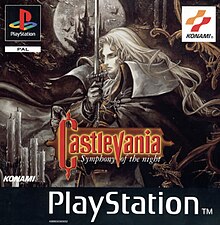
Back كاسلفينيا: سيمفوني أوف ذا نايت Arabic كاسلفينيا: سيمفونى اف ذا نايت ARZ Castlevania: Symphony of the Night Byelorussian Castlevania: Symphony of the Night Spanish کسلوانیا: سمفونی شبانه Persian Castlevania: Symphony of the Night Finnish Castlevania: Symphony of the Night French Castlevania: Symphony of the Night Italian 悪魔城ドラキュラX 月下の夜想曲 Japanese 캐슬바니아: 밤의 교향곡 Korean
| Castlevania: Symphony of the Night | |
|---|---|
 European packaging art featuring the game's protagonist, Alucard, drawn by Ayami Kojima | |
| Developer(s) | Konami Computer Entertainment Tokyo |
| Publisher(s) | Konami |
| Director(s) | Toru Hagihara |
| Producer(s) | Toru Hagihara |
| Programmer(s) |
|
| Artist(s) |
|
| Writer(s) |
|
| Composer(s) | Michiru Yamane |
| Series | Castlevania |
| Platform(s) | |
| Release | |
| Genre(s) | Action role-playing, Metroidvania |
| Mode(s) | Single-player |
Castlevania: Symphony of the Night[a] is a 1997 action role-playing game developed and published by Konami for the PlayStation and Sega Saturn.[3] It was directed and produced by Toru Hagihara, with Koji Igarashi acting as assistant director. It is a direct sequel to Castlevania: Rondo of Blood, taking place four years later. It features Dracula's dhampir son Alucard (returning from Castlevania III: Dracula's Curse) as the protagonist, rising from his slumber to explore Dracula's castle which resurfaced after Richter Belmont vanished.[4] Its design marks a break from previous entries in the series, re-introducing the exploration, nonlinear level design, and role-playing elements first experimented with in Castlevania II: Simon's Quest.[5]
Symphony of the Night initially sold poorly. However, it gradually gained sales through word-of-mouth and became a sleeper hit, developing a cult following and selling over 700,000 units in the United States and Japan. The game garnered acclaim, often cited by critics as one of the best video games of all time, praising its gameplay innovations, atmosphere, visuals and soundtrack, though the voice acting was faulted. It is also considered a pioneer of the Metroidvania genre (alongside Super Metroid), inspiring numerous exploration-based action-adventure games. Symphony of the Night would have a lasting impact on the Castlevania series, with numerous subsequent mainline entries adopting its gameplay model.
- ^ Konami (August 4, 2010). Castlevania: Harmony of Despair. Konami.
Japanese: 歴代の「悪魔城ドラキュラ」シリーズから選ばれた登場キャラクターを操作して、仲間たちと悪魔城に乗り込み、宿敵ドラキュラ伯爵に立ち向かおう。 English translation: Take control of past protagonists from the Castlevania series to brave the Demon Castle alongside friends and defeat the ancient enemy Count Dracula.
- ^ Konami Computer Entertainment Tokyo (March 20, 1997). Akumajō Dracula X: Gekka no Yasōkyoku. Konami Co., Ltd. Scene: staff credits.
- ^ "悪魔城ドラキュラX 〜月下の夜想曲〜 [PS] / ファミ通.com". Famitsu. Archived from the original on August 1, 2018. Retrieved July 24, 2018.
- ^ Bozon, Mark (January 18, 2008). "Castlevania: The Retrospective – Page 4". IGN. Archived from the original on June 11, 2011. Retrieved September 4, 2010.
- ^ Tieryas, Peter (January 15, 2018). "The Castlevania Game That Changed Everything". Kotaku. Archived from the original on January 15, 2018. Retrieved February 4, 2021.
Cite error: There are <ref group=lower-alpha> tags or {{efn}} templates on this page, but the references will not show without a {{reflist|group=lower-alpha}} template or {{notelist}} template (see the help page).